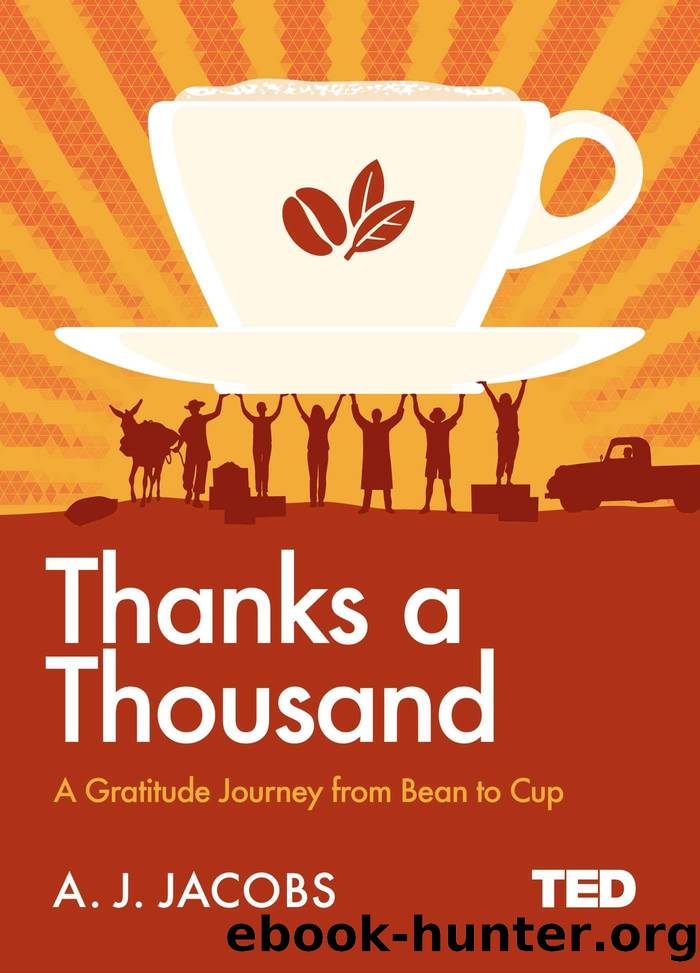Thanks a Thousand: A Gratitude Journey by A. J. Jacobs

Author:A. J. Jacobs [Jacobs, A. J.]
Language: eng
Format: epub
Tags: Family, Relationships, Friendship, Humour, Business & Professional, Self-Help, Personal Growth, Happiness
ISBN: 9781501119934
Google: vC9XDwAAQBAJ
Amazon: 1471156052
Publisher: Simon & Schuster/ TED
Published: 2018-11-13T00:00:00+00:00
7
The Extractors
Thanks for Getting All the Raw Materials
Exxonâs oil, of course, is just one of dozens of raw materials needed to conjure my coffee into existence. You need wood for the paper cup, rubber for truck tires, copper for the wiring in the roasters.
Many of these materials are extracted from the earth by corporations like Exxon, which probably donât have humanityâs well-being as their number one priority. Many a shady, shortsighted thing has been done in search of quarterly profits.
But these companies also have thousands of hardworking employees who are just trying to earn an honest living. Those people deserve my thanks, which is why Iâve traveled to Burns Harbor, Indiana, to visit one of the biggest still-operating steel mills in the United States. In the reception area I don the requisite protective gearâa helmet, a fire-retardant coat, earplugs, and a pair of white gloves.
âThose gloves will be black by the end of the day,â says Larry, my assigned guide. âYouâll help us clean the handrails around here.â
Larry is a tall, gray-haired man with a big laugh, a big stride, and an American flag sticker on his hard hat. Heâs worked in steel his whole life, as did his dad and grandfather.
As Larry says, steel is everywhere. Itâs practically womb to tomb. When I was born, I was weighed on a steel scale. When I die, Iâll probably be buried in a steel-lined coffin.
And my coffee wouldnât exist without steel. The ships and trains and trucks that carry the beans are made of steel, as are the stop signs and bridges and docks on their routes. Steel is in coffee scoopers and roasting machines, refrigerators and spoons. The owners of this millâthe Luxembourgian/Indian company ArcelorMittalâchurn out steel that can be found in almost every vehicle on the road, so it certainly played a role in my morning drink.
Larryâs coworker gives us some final words of wisdom before we head off. âNever, ever, ever run in a steel mill. Unless Larry runs. Then run real fast.â
We drive along puddle-covered roads that connect the plantâs many buildings, and I marvel at the scope of the place. We pass by hills of black coal and a field covered with hundreds of steel coils that resemble giant rolls of duct tape. We enter a huge building with a huge crane lifting a huge bucket the size of my bedroom. The bucket is filled with a glowing orange steel soup that, when tipped over, glides into a furnace.
âThatâs how we pour the coffee into the mug,â Larry says.
I wonât go into all the technical details (mostly because I didnât understand them), but the basic recipe for the steel is: take iron pellets shipped from Minnesota, mix with limestone, sinter, and coke (a form of charcoal), and heat to over four thousand degrees.
The steel gets so hot, you need special brick to hold itâbrick, incidentally, that is imported from China. As the steel is cooled, itâs molded and sliced into sheets or ribbons and sent off to carmakers and dishwasher factories.
Download
This site does not store any files on its server. We only index and link to content provided by other sites. Please contact the content providers to delete copyright contents if any and email us, we'll remove relevant links or contents immediately.
Spell It Out by David Crystal(36087)
Professional Troublemaker by Luvvie Ajayi Jones(29625)
We're Going to Need More Wine by Gabrielle Union(19004)
The Secret History by Donna Tartt(18951)
Cat's cradle by Kurt Vonnegut(15262)
The Goal (Off-Campus #4) by Elle Kennedy(13608)
The Social Justice Warrior Handbook by Lisa De Pasquale(12170)
The Break by Marian Keyes(9338)
Crazy Rich Asians by Kevin Kwan(9224)
The remains of the day by Kazuo Ishiguro(8895)
Thirteen Reasons Why by Jay Asher(8848)
Educated by Tara Westover(8004)
The handmaid's tale by Margaret Atwood(7711)
Giovanni's Room by James Baldwin(7256)
Win Bigly by Scott Adams(7142)
This Is How You Lose Her by Junot Diaz(6837)
The Rosie Project by Graeme Simsion(6300)
Six Wakes by Mur Lafferty(6203)
Beartown by Fredrik Backman(5682)
